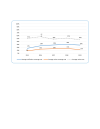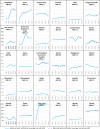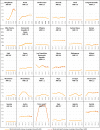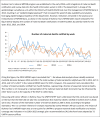Maternal death surveillance efforts: notification and review coverage rates in 30 low-income and middle-income countries, 2015-2019
- PMID: 36806138
- PMCID: PMC9944275
- DOI: 10.1136/bmjopen-2022-066990
Maternal death surveillance efforts: notification and review coverage rates in 30 low-income and middle-income countries, 2015-2019
Abstract
Objective: Performance of maternal death surveillance and response (MDSR) relies on the system's ability to identify and notify all maternal deaths and its ability to review all maternal deaths by a committee. Unified definitions for indicators to assess these functions are lacking. We aim to estimate notification and review coverage rates in 30 countries between 2015 and 2019 using standardised definitions.
Design: Repeat cross-sectional surveys provided the numerators for the coverage indicators; United Nations (UN)-modelled expected country maternal deaths provided the denominators.
Setting: 30 low-income and middle-income countries responding to the Maternal Health Thematic Fund annual surveys conducted by the UN Population Fund between 2015 and 2019.
Outcome measures: Notification coverage rate ([Formula: see text]) was calculated as the proportion of expected maternal deaths that were notified at the national level annually; review coverage rate ([Formula: see text]) was calculated as the proportion of expected maternal deaths that were reviewed annually.
Results: The average annual [Formula: see text] for all countries increased from 17% in 2015 to 28% in 2019; the average annual [Formula: see text] increased from 8% to 13%. Between 2015 and 2019, 22 countries (73%) reported increases in the [Formula: see text]-with an average increase of 20 (SD 18) percentage points-and 24 countries (80%) reported increases in [Formula: see text] by 7 (SD 11) percentage points. Low values of [Formula: see text] contrasts with country-published review rates, ranging from 46% to 51%.
Conclusion: MDSR systems that count and review all maternal deaths can deliver real-time information that could prompt immediate actions and may improve maternal health. Consistent and systematic documentation of MDSR efforts may improve national and global monitoring. Assessing the notification and review functions using coverage indicators is feasible, not affected by fluctuations in data completeness and reporting, and can objectively capture progress.
Keywords: HEALTH SERVICES ADMINISTRATION & MANAGEMENT; International health services; Maternal medicine; PUBLIC HEALTH.
© Author(s) (or their employer(s)) 2023. Re-use permitted under CC BY-NC. No commercial re-use. See rights and permissions. Published by BMJ.
Conflict of interest statement
Competing interests: None declared.
Figures






References
-
- United Nations Secretary General . Global strategy for women’s and children’s health (2010–2015). New York: United Nations, 2010.
-
- UN Economic and Social Council . Commission on the status of women. report on the fifty-sixth session. Resolution 56/3. Eliminating maternal mortality and morbidity through the empowerment of women. New York, United Nations. 2012:12–22.
-
- UN . Transforming our world: the 2030 agenda for sustainable development resolution A/RES/70/1. adopted september, 2015. Geneva: United Nations; 2015.
-
- WHO . Accountability commission for health of women and children. 2011. Available: https://www.who.int/topics/millennium_development_goals/accountability_c... [Accessed 5 May 2021].
-
- WHO . Trends in maternal mortality: 2000 to 2017: estimates by WHO, UNICEF, UNFPA, world bank group and the united nations population division. Geneva: WHO, 2019.
MeSH terms
Grants and funding
LinkOut - more resources
Full Text Sources
